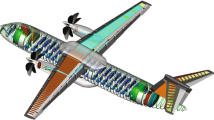Abstract
The paper presents the results of a study of the flight dynamics of a hypothetical maneuverable airplane, the shortcomings of the stability and controllability characteristics of which are compensated by algorithms of the system of improving stability and controllability by introducing a complex border of the permissible angle of attack depending on the flight mode. The research was based on a mathematical model of the airplane as a material point, taking into account the restrictions on altitude and flight speed, g-load, angle of attack, as well as the rate of change of g-load and roll. The purpose of the research is to establish the effect of the operation of the specified control system algorithms on the nature and area of safe execution of the "coup-type" maneuver. As a result of the research, it was found that the functioning of special algorithms of the electric remote-control system, leads to the emergence of areas of the operational range of altitudes and flight speeds, in which there is a significant and sharp deterioration of the maneuverability of the aircraft. Consequently, any "improvement" of the aircraft's flight performance using an automatic control system requires an assessment of the effect of these changes on the aircraft's maneuverability in all possible flight modes.









Similar content being viewed by others
Availability of data and materials
Not applicable.
Code availability
Not applicable.
Abbreviations
- c xa :
-
Drag coefficient
- c y a :
-
Lifting force coefficient
- M :
-
Mach velocity
- αperm :
-
Permissible angle of attack
- zg :
-
Coordinates of the aircraft in the normal earth coordinate system along the z-axis
- x g :
-
Coordinates of the aircraft in the normal earth coordinate system along the x-axis
- V instr :
-
Instrumental velocity [m/s]
- V :
-
Aircraft velocity
- S :
-
Wing area
- P :
-
Propulsion thrust
- n ya norm :
-
Normal available overload
- \(n_{y\max }^{per}\) :
-
Maximum permissible operating overload
- n y :
-
Normal overload
- n ya :
-
Normal speed overload
- n xa :
-
Normal tangential overload
- α:
-
Angle of attack [deg]
- m :
-
Aircraft weight [kg]
- H :
-
Coordinates of the aircraft in the normal earth coordinate system along the H-axis
- H min :
-
Minimum flight altitude [m]
- g :
-
Free fall acceleration
- G :
-
Weight [H]
- c sec :
-
Fuel flow rate per second [kg/sec]
- αECL :
-
Engine control lever position [deg]
- φeng :
-
Engine setting angle [deg]
- γa :
-
Roll angle [deg]
- γya -max :
-
Maximum roll angle [deg]
- ρH :
-
Air density at altitude H [kg/m3]
- θ:
-
Angle of slope of the path [deg]
- Ψ:
-
Path angle [deg]
- ρ:
-
Air density [kg/m3
References
Xin M (2014) Unified nonlinear optimal flight control and state estimation of highly maneuverable aircraft. Aerosp Sci Technol. https://doi.org/10.1016/j.ast.2014.05.001
Serebryansky S, Barabanov A (2020) To the question of multi-criteria optimization of aircraft components in order to optimize its life cycle. Adv Sci Technol Eng Syst J. https://doi.org/10.25046/aj050649
Kulchak AM, Kosyanchuk VV, Zybin EY (2018) Reconfiguration of integrated aircraft control system in case of actuator failures with regard to control constraints. Sci Bulle Mosc State Tech Univ GA. 21(6):65–78. https://doi.org/10.26467/2079-0619-2018-21-6-65-78
Mohamed M, Madhavan G (2020) Reduced order model-based flight control system for a flexible aircraft. IFAC-PapersOnLine. https://doi.org/10.1016/j.ifacol.2020.06.013
Aircraft Accident Investigation Report (2018) PT. Lion Airlines Boeing 737 (MAX)// PK-LQP TanjungKarawang, West Java, Republic of Indonesia 29 October 2018. National Transportation Safety Committee
Interim Investigation Report of accident 737-8 MAX ET-AVJ, ET-302. Aircraft Accident Investigation Bureau 10 March 2019, Ministry of Transport the Federal Democratic Republic of Ethiopia
737 MAX SOFTWARE UPDATE. Overview. Electronic resource. Access mode: URLhttps://www.boeing.com/commercial/737max/737-max-software-updates.page. Access date 02 Dec 2020
Mereau P, Abu El, Ata-Doss S (1985) Parameter estimation of aircraft with fly-by-wire control systems. IFAC Proc Vol. https://doi.org/10.1016/S1474-6670(17)60610-4
Arbuzov IV, Serebryanskii SA, Strelets DY (2019) Forming the technical concept of aircraft power systems of the perspective aircraft taking into account the outside mechani-cal impacts. In: 2019 IEEE 10th International Conference on Mechanical and Aerospace Engineering (ICMAE), Brussels, Belgium, pp 85–88, https://doi.org/10.1109/ICMAE.2019.8880969
FAA Updates on Boeing 737 MAX//Electronic resource. Access mode: URLhttps://www.faa.gov/news/updates/?newsId=93206. Accessed 02 Dec 2020
Korsun O, Sergeev S, Stulovskii A (2019) Optimal control design for maneuverable air-craft using population-based algorithms. Procedia Comput Sci. https://doi.org/10.1016/j.procs.2019.02.064
Majeed M, Singh J, Kar I (2012) Identification of aerodynamic derivatives of a flexible air-craft. J Aircr 49(2):654–658. https://doi.org/10.2514/1.C031318
Cao Z, Jia T, Niu Y (2020) Self-triggered sliding mode control for digital fly-by-wire air-craft system. J Frankl Inst. https://doi.org/10.1016/j.jfranklin.2020.08.028
Tomczyk A (2005) Aircraft maneuverability improvement by direct lift control system ap-plication. Aerosp Sci Technol. https://doi.org/10.1016/j.ast.2005.09.004
Bucharles A, Vacher P (2002) Flexible aircraft model identification for control law design. Aerosp Sci Technol 6(8):591–598. https://doi.org/10.1016/S1270-9638(02)01197-5
Balyk OA (2016) Methodology of testing aircraft in super maneuverability modes. Aviapanorama 6(120):34–41
Soldatkin VM (2004) Methods and tools for building onboard information control systems ensure flight safety. KGTU, Kazan
Levitsky SV, Sviridov NA (2008) Flight dynamics. Textbook. Edited by S.V. Levitsky. VVIA Publishing House named after N.E. Zhukovsky, Moscow, p 526
Kiselev MA (2007) An algorithm of an aircraft turn executed with maximum angular velocity. J Comput Syst Sci Int 46(5):815–825
Funding
The authors received no financial support for the research, authorship, and publication of this article.
Author information
Authors and Affiliations
Corresponding author
Ethics declarations
Conflict of interest
The authors declared no potential conflicts of interest with respect to the research, authorship, and publication of this article.
Rights and permissions
About this article
Cite this article
Kiselev, M., Levitsky, S. & Shkurin, M. Influence of control system algorithms on the maneuvering characteristics of the aircraft. AS 5, 123–130 (2022). https://doi.org/10.1007/s42401-021-00124-8
Received:
Revised:
Accepted:
Published:
Issue Date:
DOI: https://doi.org/10.1007/s42401-021-00124-8




